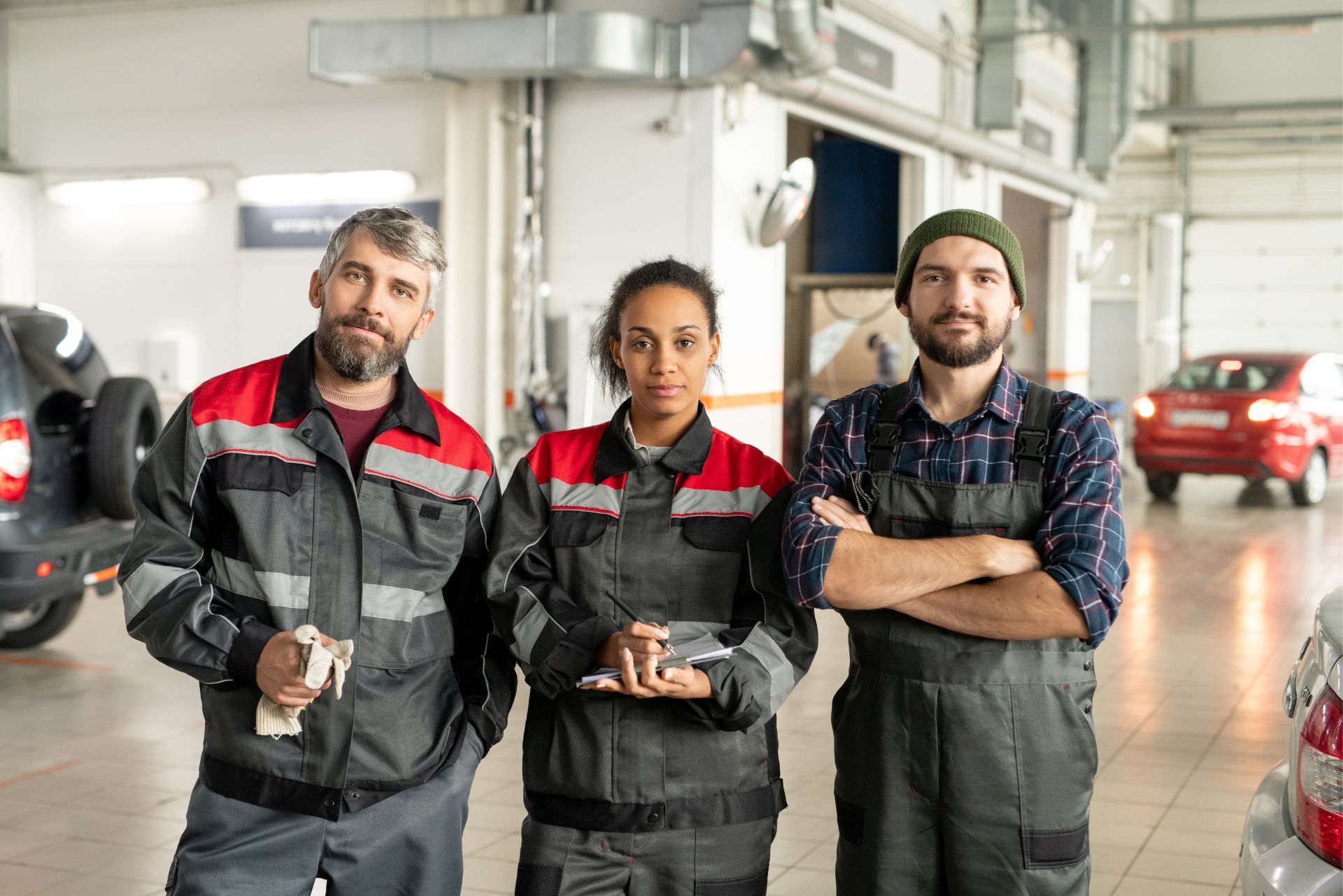Top 3 Recommended Policies

By: Lance Hale
Licensed Commercial Insurance Specialist
425-320-4280
Automotive repair shops, body shops, detailers, towing companies and even quick-lube lanes in Washington handle customer vehicles every single day. When those vehicles are left in the shop’s care, custody or control, the business becomes responsible for any damage that occurs while they are on the premises or being test-driven. Garage keepers insurance is the policy designed to respond to this very situation. Without it, a single fender-bender or overnight fire could erase years of hard-earned profit. The guide below breaks down how garage keepers coverage works in Washington, when it is mandatory, what it costs, and how to secure the right protection for any size operation.
What Is Garage Keepers Insurance?
Garage keepers insurance is a specialized form of property coverage that protects customer automobiles while they are in the care of a garage-related business. Unlike a general liability policy, which focuses on bodily injury and property damage to others, garage keepers coverage specifically addresses losses to the customers’ vehicles themselves. Typical covered perils include fire, theft, vandalism, hail, explosion, and collision—whether the incident occurs inside a service bay, in a fenced lot, or on a public road during a test drive.
The coverage can be written on three separate legal forms—“legal liability,” “direct primary,” and “direct excess.” Each form determines when the policy pays and whether the customer’s personal auto insurance is tapped first. Selecting the proper form can prevent disputes at claim time and preserve the customer relationship, which is why agents often spend extra time reviewing the options with repair shop owners before binding the policy.
In addition to the basic coverage options, garage keepers insurance can also include endorsements that enhance the policy's scope. For instance, some businesses may opt for coverage that includes rental reimbursement, which can be a significant advantage for customers who require a temporary vehicle while theirs is being repaired. This not only adds value to the service provided by the garage but also fosters customer loyalty, as clients appreciate the convenience and support during their time of need. Furthermore, businesses can explore coverage for tools and equipment, ensuring that their operational assets are also protected against theft or damage, which can be crucial for maintaining business continuity.
Moreover, understanding the nuances of garage keepers insurance is essential for business owners, especially in an industry where customer trust is paramount. The reputation of a garage can hinge on how well it handles claims and protects customer vehicles. Regular training sessions for staff on the importance of this insurance can help create a culture of awareness and responsibility. Additionally, maintaining clear communication with customers about what is covered under the policy can help manage expectations and enhance customer satisfaction. By prioritizing these aspects, garage owners not only safeguard their business but also build lasting relationships with their clientele, ultimately contributing to their success in a competitive market.
Why Washington Shops Face Unique Risks
Washington has one of the most diverse climates in the country, ranging from coastal rainforests in the west to arid high desert in the east. Heavy rainfall, ice storms, and the occasional wildfire all pose threats to vehicles stored overnight. According to the Washington State Department of Ecology, the Puget Sound region alone records more than 150 wet days a year. Leaky roofs, wind-borne debris, and flash flooding can quickly turn an otherwise ordinary night of storage into a six-figure claim. The unpredictable nature of the weather means that shop owners must be vigilant, ensuring that their facilities are equipped to handle sudden storms and the potential for water damage. Regular maintenance checks and upgrades to drainage systems can be essential in mitigating these risks, but even the best preparations can be tested by nature's fury.
Auto theft is also a growing concern. The Washington Association of Sheriffs and Police Chiefs reported more than 46,000 vehicle thefts statewide in the most recent annual survey—a 31 percent jump over the previous year. Repair facilities and tow yards are attractive targets because dozens of keys are often accessible, and security measures may be inconsistent. In urban areas like Seattle and Tacoma, the risk is even higher, as thieves often operate in organized rings that specifically target auto shops. This escalation in crime has prompted many shop owners to invest in advanced security systems, including surveillance cameras and alarm systems, to deter potential thieves. However, these measures can only do so much, and the combination of weather volatility with rising crime makes the case for robust garage keepers insurance stronger than ever in the Evergreen State. Additionally, shop owners must remain vigilant and proactive, fostering relationships with local law enforcement to stay informed about crime trends and prevention strategies.

Key Coverages Explained
Each garage keepers form contains similar language, yet subtle differences can change the outcome of a claim significantly. Understanding how the three primary options work, as well as which endorsements pair well with them, helps Washington shop owners build a policy that fits their risk tolerance and cash-flow expectations.
Direct Primary Coverage
Direct primary coverage places the repair shop’s policy first in line, regardless of fault. If a hydroplaning incident occurs during a post-repair test drive, the garage keepers insurer pays to repair the customer’s vehicle without seeking contribution from the customer’s personal insurer. Direct primary is popular with dealerships and premium import specialists in Seattle and Bellevue, because high-net-worth customers expect their vehicles to be returned quickly with as little red tape as possible.
Legal Liability Coverage
Legal liability is the leanest—and least expensive—form. It pays only when the shop is legally responsible for damage. For instance, if a mechanic forgets to latch a hood and the panel slams into the windshield on the highway, the policy responds. However, if a tornado rips through Pullman and damages every car on the lot, the insurer may deny claims with the argument that no negligence existed. Shops choosing legal liability should budget an emergency fund for no-fault losses because customer dissatisfaction could still cost valuable repeat business.
Direct Excess Coverage
Direct excess sits between the previous two options. The customer’s auto insurance remains primary, but once those limits exhaust, the garage keepers policy pays what is left, up to its stated limit. Collision repairs frequently exceed $25,000 on newer vehicles, so direct excess is a reasonable middle ground for midsize garages in Spokane or Yakima that service a broad mix of vehicle values. Premiums run about 15 percent higher than legal liability but can still be 10–20 percent lower than direct primary, keeping overhead manageable.
Optional Endorsements
Several endorsements can enhance a Washington garage keepers policy. “On-hook towing” extends coverage to customer vehicles being towed, an important add-on for roadside service contractors. “Drive-other-car” coverage protects employees who occasionally take customer vehicles home after hours. “False-pretense” coverage addresses losses when someone acquires a vehicle through fraud, such as presenting a stolen identity to reclaim impounded cars. Evaluating these endorsements annually prevents gaps created by evolving business models or new revenue streams.
Legal Requirements in Washington
Washington does not mandate garage keepers insurance statewide, but several regulatory bodies and contractual partners effectively require it. The Washington State Patrol sets minimum insurance standards for tow truck operators seeking rotational call privileges; without proof of garage keepers or on-hook coverage, a tow company cannot join the rotation list, forfeiting a significant source of traffic accident revenue. In addition, many city business license departments, including those in Tacoma and Everett, require evidence of garage liability and garage keepers when issuing or renewing automotive repair licenses.
Lenders also weigh in. Banks that finance equipment, property or floor-plan inventory routinely require garage keepers insurance, naming the bank as an additional insured and loss payee. Failure to carry the agreed limits can trigger loan default clauses. Even landlords get involved; commercial leases for repair bays in King County industrial parks often stipulate minimum garage keepers limits of $100,000 per vehicle and $1 million aggregate. Ignoring insurance language buried in a lease can lead to costly penalties or eviction, so legal counsel should review all agreements before signing.
Cost Factors and Saving Tips
Premiums for garage keepers insurance in Washington vary widely, from as little as $1,200 a year for a rural two-bay repair shop to more than $35,000 for a metropolitan dealership storing luxury fleets. Insurers analyze a matrix of factors, including average number of vehicles stored, total lot value at peak season, building construction, local crime rate, fire-protection class, and whether test drives exceed 300 yards from the premises. Shops located within 1,000 feet of a fire hydrant and staffed with I-CAR certified technicians typically receive favorable rates, reflecting a lower likelihood of accidental losses.
Smart owners can soften premium spikes without underinsuring. Installing UL-listed central station alarms, high-definition surveillance cameras, automatic fire suppression systems and perimeter fencing may qualify a shop for protective-device credits up to 15 percent. Raising the per-vehicle deductible from $250 to $1,000 can cut another 8–12 percent, provided cash flow can absorb occasional small losses. Bundling garage keepers with commercial property, workers’ compensation and cyber coverage under a single package policy also triggers multi-line discounts. Regularly updating the schedule of customer vehicles—especially during seasonal lulls—prevents overpayment on exposures that no longer exist.
Real-World Claims: Lessons Learned
Statistics are helpful, but actual claims show how garage keepers insurance functions under pressure. The following Washington-based scenarios, drawn from carrier loss reports and public court filings, illustrate why thorough coverage matters.
After-Hours Joyride Gone Wrong
An employee at a Seattle collision center used the shop’s master key ring to take a freshly painted sports car for an unauthorized midnight drive. The employee struck a concrete barrier on Interstate 5, causing $42,000 in damage. Surveillance footage confirmed unauthorized use, yet the shop was still held responsible because the vehicle was legally in its custody. The direct primary garage keepers policy covered the full repair, minus a $1,000 deductible. The claim would have been denied under legal liability coverage, leaving the owner to sue the employee and potentially lose a client.
Wildfire Embers Ignite Storage Lot
During the 2020 wildfire season, wind-blown embers from the Evans Canyon Fire reached a Yakima Valley service center. Three customer vehicles were scorched, resulting in $87,000 in combined losses. Investigators found no negligence, yet the shop carried direct excess coverage with a $250,000 aggregate limit. Two customers had only state-minimum auto physical damage coverage, so their personal policies paid little. The garage keepers insurer covered the balance, sparing the family-owned business from exhausting its emergency funds.
Software Glitch in Keyless Entry System
A dealer in Spokane Valley installed an aftermarket keyless-entry system on a customer’s SUV. A coding error caused the engine to start inside a closed garage bay overnight, filling the bay with exhaust and damaging paint on a neighboring vehicle. Total loss: $19,300. Because negligence was clear, coverage applied even under the legal liability form. The insurer also paid an additional $2,500 in lost use to the second customer, reinforcing the value of adequate per-vehicle limits.
How to Choose the Right Policy
Comparing garage keepers quotes is about more than finding the lowest premium. Start by confirming that the insurer understands Washington’s specific exposures—coastal weather, seismic activity and a rising rate of catalytic converter thefts. National carriers with regional underwriting centers in the Pacific Northwest tend to price these risks more accurately than companies that rely on broad national averages.
Next, scrutinize sub-limits and exclusions. Many policies cap coverage for sound systems or custom paint jobs at $5,000 unless endorsed higher. Others exclude hail damage altogether east of the Cascades. Request specimen policy forms, not just summaries, and verify that endorsements such as on-hook towing, false-pretense and drive-other-car are attached where applicable. Finally, ask the agent to run a catastrophe modeling report on the shop’s ZIP code. Exposure to landslide or flood zones might necessitate separate coverage, and discovering that need before a claim makes all the difference.

Frequently Asked Questions
The complexity of garage keepers insurance often sparks recurring questions. Addressing them upfront saves time during the quoting process and ensures expectations match reality.
Is garage keepers insurance the same as garage liability?
No. Garage liability addresses third-party bodily injury or property damage, such as a slip-and-fall in the waiting room or a wheel that detaches on the highway after repair. Garage keepers, by contrast, protects customer vehicles themselves while in the shop’s care. Most Washington auto service businesses carry both policies because they complement, not replace, each other.
How much coverage is recommended per vehicle?
Industry consultants generally advise limits equal to or slightly higher than the most expensive vehicle likely to be on the premises. Urban dealerships might set per-vehicle limits at $150,000 to accommodate luxury SUVs, while a tire shop in Wenatchee may find $50,000 sufficient. Seasonal fluctuations—such as convertible storage in summer—should also influence limit selection.
Does garage keepers insurance cover test drives?
Yes, as long as the vehicle remains in the shop’s care, custody or control. Most policies define that condition as extending to road tests within a reasonable radius, often five to ten miles. However, recreational use—taking a classic car to a weekend show, for example—typically falls outside the policy’s scope and requires specific written permission from the insurer.
Are customer belongings inside a vehicle covered?
Personal property left in a customer’s vehicle, such as laptops or expensive tools, is usually excluded or severely limited—often to $500. Shops can mitigate disputes by posting clear signage advising customers to remove valuables and by including property disclaimers on work orders. Separate “personal effects” endorsements exist, but few insurers offer limits above $5,000 due to high theft frequency.
Final Thoughts
Washington’s automotive service landscape is evolving, and with it comes a shifting array of exposures that can threaten even the most experienced operators. From heavy coastal rain to wildfire ash, from catalytic-converter theft to high-tech keyless ignition glitches, today’s risks look very different than they did a decade ago. Garage keepers insurance remains the single most effective tool for transferring those risks away from the balance sheet and onto a carrier equipped to absorb them. By understanding coverage forms, staying alert to regulatory requirements, investing in preventive security and partnering with knowledgeable insurance professionals, Washington garage owners can focus on what they do best—keeping the state’s vehicles safe, reliable and on the road—without losing sleep over the financial fallout of an unexpected loss.

